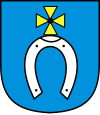 Alternate names: Lutowiska [Pol], Litovisk [Yid], Szewczenkowo [Pol, 1951-57], Litevisk, Lutoviska. ליטוביסק [ Yid]. לוטוביסקה [Hebr]. 49°15' N, 22°42' E, 37 miles S of Przemyśl, 22 miles SE of Lesko (Lisko), near the Ukrainian border. 1900 Jewish population: 1,570. Yizkors: Sefer yizkor; mukdash le-yehudei ha-ayarot she-nispu ba-shoa be-shanim 1939-44, Linsk, Istrik, Beligrod, Litovisk veha-sevivah (Tel Aviv, 1965) and Pinkas ha-kehilot; entsiklopediya shel ha-yishuvim le-min hivasdam ve-ad le-aher shoat milhemet ha-olam ha-sheniya: Poland vol. 2: Eastern Galicia (Jerusalem, 1980). Słownik Geograficzny Królestwa Polskiego (1880-1902), V, p. 491: "Lutowiska". Lutowiska is a village in Bieszczady powiat, Subcarpathian Voivodeship in south-eastern Poland to the border with Ukraine and the seat of the administrative district called Gmina Lutowiska. The vilage 22 km (14 mi) S of Ustrzyki Dolne and 101 km (63 mi) SE of the regional capital Rzeszów has a population of 750. Gmina Lutowiska contains the villages, settlements and former villages of Beniowa, Bereżki, Brzegi Górne, Bukowiec, Caryńskie, Chmiel, Dwerniczek, Dwernik, Dydiowa, Dźwiniacz Górny, Hulskie, Krywe, Krywka, Łokieć, Lutowiska, Muczne, Nasiczne, Procisne, Pszczeliny, Sianki, Skorodne, Smolnik, Sokoliki Górskie, Stuposiany, Tarnawa Niżna, Tarnawa Wyżna, Ustrzyki Górne, Wołosate, Zatwarnica and Żurawin. [June 2009]
Alternate names: Lutowiska [Pol], Litovisk [Yid], Szewczenkowo [Pol, 1951-57], Litevisk, Lutoviska. ליטוביסק [ Yid]. לוטוביסקה [Hebr]. 49°15' N, 22°42' E, 37 miles S of Przemyśl, 22 miles SE of Lesko (Lisko), near the Ukrainian border. 1900 Jewish population: 1,570. Yizkors: Sefer yizkor; mukdash le-yehudei ha-ayarot she-nispu ba-shoa be-shanim 1939-44, Linsk, Istrik, Beligrod, Litovisk veha-sevivah (Tel Aviv, 1965) and Pinkas ha-kehilot; entsiklopediya shel ha-yishuvim le-min hivasdam ve-ad le-aher shoat milhemet ha-olam ha-sheniya: Poland vol. 2: Eastern Galicia (Jerusalem, 1980). Słownik Geograficzny Królestwa Polskiego (1880-1902), V, p. 491: "Lutowiska". Lutowiska is a village in Bieszczady powiat, Subcarpathian Voivodeship in south-eastern Poland to the border with Ukraine and the seat of the administrative district called Gmina Lutowiska. The vilage 22 km (14 mi) S of Ustrzyki Dolne and 101 km (63 mi) SE of the regional capital Rzeszów has a population of 750. Gmina Lutowiska contains the villages, settlements and former villages of Beniowa, Bereżki, Brzegi Górne, Bukowiec, Caryńskie, Chmiel, Dwerniczek, Dwernik, Dydiowa, Dźwiniacz Górny, Hulskie, Krywe, Krywka, Łokieć, Lutowiska, Muczne, Nasiczne, Procisne, Pszczeliny, Sianki, Skorodne, Smolnik, Sokoliki Górskie, Stuposiany, Tarnawa Niżna, Tarnawa Wyżna, Ustrzyki Górne, Wołosate, Zatwarnica and Żurawin. [June 2009]
Jews settled in Lutowiska in the 18th century, with 1,309 Jews living there in 1881 dominating the local trade. On the main road to Carpatho-Rus and Hungary and the nearby estates to Graf [Count] Konarski, 12 big annual fairs in Lutowiska were known for trade in oxen imported from Hungary. With its agricultural surroundings, the local weekly market was important. The Jewish cemetery on a hill about four hundred meters east of the city beside the river Smolnik was also a burial place for Jews from Lutowiska, Stuposianów, Zatwarnicy, Skorodnego and other nearby villages. During a 1997-2002 inventory carried out under the supervision of prof. Jerzego Woronczaka, about a thousand graves were identified, the oldest dated December 5, 1896 (5 Kislev 5557) and the newest from 1940. The new (upper) and old (lower) parts can be distinguished. The artistic values and the number of graves merit conservation. photos. photo. [May 2009] synagogue photo. Jewish history. [August 2005]
US Commission No. POCE000728
The town is in Krosno region at 49º16N and 22º42E, 54 km from Soinok and 95 km from Krosno. The cemetery is 400 meters NE of village center. Present population is under 1,000 with no Jews.
- Town: Urzad (Office) Gminy, 38-713 Lutowiska, telex 652 11 ug, tel. 73.
- Regional: the same as for Baligrod-Wojewodski Konserwator. subytkow-mgr. Alojzy Cabata, ul Bieszisadzka 1, 38-400 Krosno, tel 21-974.
1921 Orthodox Jewish population was 1220 persons. The isolated rural hillside has no sign or marker. Reached by crossing private property, access is open to all with no wall, fence, or gate. The cemetery size is approximately 1.0 ha, both before World War II and now. 100 and 500 gravestones, 20-100 not in original locations with 25%-50% toppled or broken, date from 1796-20th century. The sandstone, finely smoothed and inscribed, or flat stones with carved relief decoration have Hebrew inscriptions. There are no known mass graves. The unknown owner uses property for animal grazing. Properties adjacent are agricultural. Rarely, private persons visit. The cemetery was vandalized during World War II. In 1987 and 1988, the Society for Protection of Monuments cleared vegetation and re-erected stones but gives no care now. Weather erosion, vegetation and vandalism are very serious threats. Security is a moderate threat.
Piotr Antonioik, ul. Dobro 5 m 36, 05-800 Prusekow completed this survey on September 11, 1992. He visited the site on August 9, 1992.
[UPDATE] Photos by Charles Burns [March 2016]
